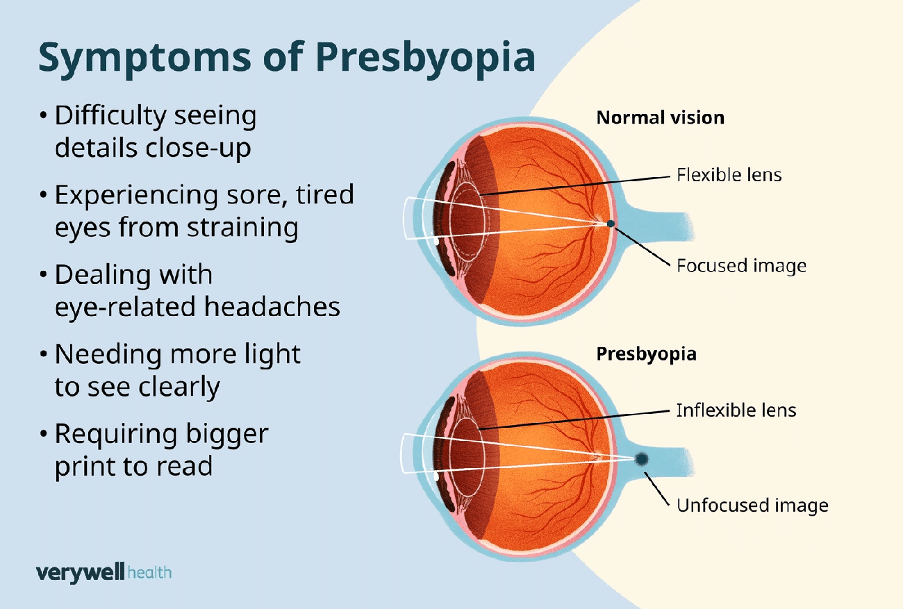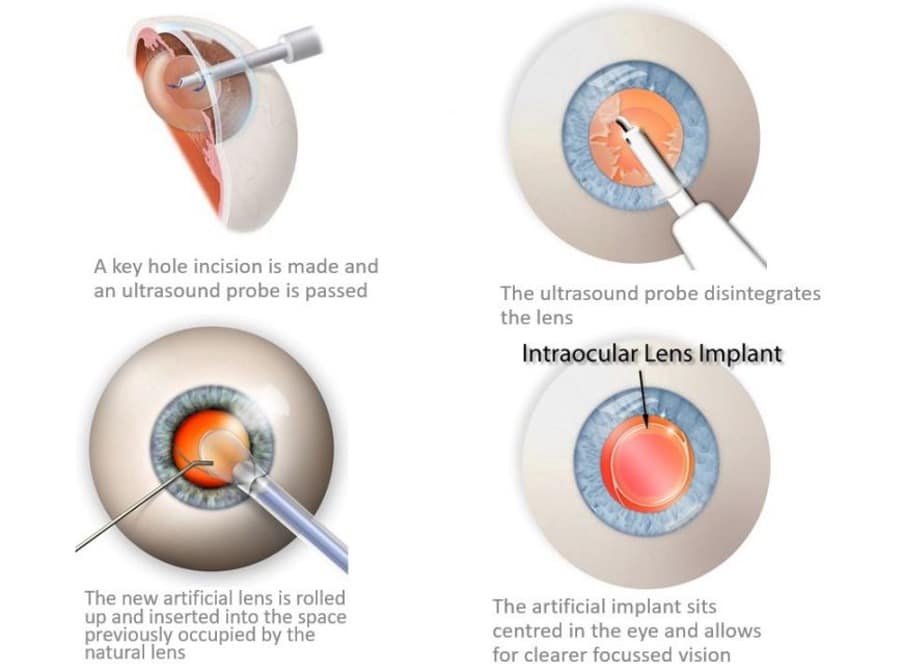Do you need to hold this text at arm’s length to read it? Laser eye surgery for presbyopia might be exactly what you need. The term presbyopia comes from Greek words that mean ‘old eye’ and starts affecting people’s vision after age 40. This age-related farsightedness ranks among the most common eye conditions that affects almost everyone as they grow older.
People notice presbyopia at the time they need to hold books and phones farther away to see the text clearly. Your lens’s ability to focus on close objects decreases substantially by age 60. Modern presbyopia treatments now reach way beyond traditional reading glasses. Research shows that LASIK monovision increased vision satisfaction among presbyopic patients from about 65% to over 85%. This piece explains how presbyopia correction methods work, the advantages of laser eye surgery options, and key factors to think about before choosing eye surgery as a lasting solution.
Understanding Presbyopia and Its Impact on Near Vision

Image Source: Verywell Health
Presbyopia affects almost everyone as we age, with approximately 1.8 billion people (25% of the global population) experiencing this condition. Your near vision starts to deteriorate around age 40-45 and continues to progress until about age 65.
Age-related lens stiffening and loss of focus
Physiological changes in your eye’s lens cause presbyopia. Your lens stays soft and flexible during early decades and changes shape easily to focus on objects at different distances. This process—called accommodation—helps light land exactly on your retina for clear vision.
Your lens changes in two important ways as you age. It becomes more rigid and less flexible. Your lens also grows thicker as new cell layers form (as with an onion’s structure). These changes make it harder for your lens to adjust thickness when focusing.
Your distance vision usually stays unchanged, but you’ll find it harder to focus on nearby objects. The power to accommodate decreases significantly over time—from approximately 20 dioptres in childhood (focusing at 50mm) to just 0.5-1 dioptre by age 60 (focusing only down to 1-2 metres).
Common symptoms: eye strain, blurred near vision
People first notice presbyopia symptoms between ages 40-45. The main symptoms include:
- Problems reading small print, especially in dim light
- Reading materials held at arm’s length
- Blurry vision at normal reading distance (about 35cm)
- Eye strain or headaches after reading or close work
- Need for brighter light when reading
- Feeling like your arms are “too short” to hold reading materials comfortably
Digital devices can make these problems worse, causing dry eyes, fatigue, and tears after long periods of use.
Why reading glasses are not a long-term solution
Reading glasses quickly relieve presbyopia symptoms but have several drawbacks. Your eyes might need stronger prescriptions over time as they get used to the magnification. The muscles that control your eye’s lens can weaken, which means you might need stronger glasses later.
Switching between regular and reading glasses becomes annoying, especially if you lead an active lifestyle. Many people find this constant change frustrating, particularly during activities that need different focusing distances. Poorly prescribed reading glasses can cause eye strain. They also remind you of ageing, which some people find discouraging.
These limitations make advanced presbyopia correction methods like laser eye surgery worth learning about, especially if you want a more permanent solution to age-related vision changes.
How Laser Eye Surgery Adapts to Presbyopia
Laser eye surgery techniques face unique challenges with presbyopia compared to standard vision problems. Doctors must adapt traditional correction methods because the biggest problem isn’t the cornea’s shape but the lens losing its flexibility.
LASIK vs PRK: Surface reshaping techniques
LASIK and PRK are the main approaches to laser vision correction. These procedures reshape the cornea differently. The surgeon creates a thin corneal flap during LASIK. They lift this flap to reshape underlying tissue with lasers before putting it back in place. PRK takes a different approach. The surgeon removes the top epithelial layer completely before using lasers to reshape the cornea.

Both procedures work well to correct refractive errors, but recovery times vary by a lot. LASIK patients see better vision within days, while PRK patients need about a month for full vision recovery. The final visual results match up well when skilled surgeons perform either procedure.
Why traditional LASIK doesn’t fix lens flexibility
Traditional LASIK works great for nearsightedness and farsightedness but can’t solve presbyopia’s core issue. The problem stems from age-related lens stiffening rather than corneal irregularities. Standard corneal reshaping offers limited help.
Laser refractive surgeries work by changing how the cornea focuses light. In spite of that, these procedures can’t bring back the natural flexibility of your crystalline lens that helps with near vision. Surgeons need additional techniques to overcome this limitation.
Monovision correction: One eye for near, one for far
Monovision offers a clever twist on laser eye surgery to treat presbyopia. Surgeons correct the dominant eye for distance vision and slightly under-correct the other eye for near vision. The brain learns to use each eye based on viewing distance.
The brain blends these different visual inputs, which lets you see well at multiple distances without reading glasses. This technique doesn’t work for everyone though. About 85% of patients adapt well to monovision. Some people have trouble with depth perception or find it hard to adjust to seeing differently through each eye.
Your surgeon will likely suggest trying monovision contact lenses first to see how well you adapt. This trial run helps show if you’re among the 95% of people who might benefit from advanced options like PRESBYOND® Laser Blended Vision.
PRESBYOND® and Other Advanced Surgical Options
Modern presbyopia treatment has evolved beyond simple monovision techniques. Several groundbreaking surgical options now give patients better vision restoration at all distances. These options help patients who struggle with age-related reading challenges.
Blended vision explained: Dominant vs non-dominant eye
PRESBYOND® Laser Blended Vision creates a customised visual balance between your eyes. Your dominant eye adapts to distance vision with some near capability. The non-dominant eye focuses on near vision while retaining some distance capability. Your brain merges images from both eyes in a “blend zone” that establishes a continuous connection across all distances.
Traditional monovision gives eyes separate functions. PRESBYOND® is different because it extends each eye’s range of focus. This difference is vital—your brain combines visual information naturally and creates seamless vision. You won’t experience the disorientation that comes with traditional approaches.
Wavefront-guided laser reshaping for presbyopia correction
PRESBYOND® uses sophisticated wavefront technology to analyse your eye’s unique optical properties. The treatment fine-tunes depth of focus for each eye by incorporating preoperative wavefront data. Your eye’s natural spherical aberrations help extend focus range beyond conventional monovision limits.
Your specific visual characteristics and functional eye age determine personalised ablation profiles. The treatment selects different optical zones based on pupil size. This ensures optimal visual outcomes that match your needs.
Comparison: PRESBYOND vs standard monovision LASIK
PRESBYOND® works for approximately 97% of presbyopia patients. Standard monovision only works for 60% of patients. PRESBYOND® maintains stereoacuity without losing contrast sensitivity. Patients rarely experience side effects like multiple images in one eye—a common issue with conventional monovision.
Patients with moderate to high myopia reported 94.3% satisfaction with monovision LASIK. Alternative options showed 79.1% satisfaction. Most patients adapt within one week to six months with mild adjustment symptoms.
Lens replacement surgery as an alternative
Refractive lens exchange (RLE) provides another way to correct presbyopia, especially for patients over 50. RLE replaces your eye’s natural lens with an artificial intraocular lens (IOL). You can choose between multifocal IOLs with different distance zones or accommodating IOLs that work like natural focusing.

RLE involves more invasion than laser procedures but eliminates future cataract risks. The procedure costs between approximately £3,900 and £5,100 per eye. This includes medication and follow-up care. Reading glasses don’t have to be permanent. Find your options for presbyopia correction with expert laser eye surgeons at Precision Vision London—book now!
Risks, Recovery, and Who Should Consider Surgery
Your brain’s knowing how to adapt to a new visual system largely determines successful vision correction after presbyopia surgery. Approximately 81% of patients adapt successfully to monovision after 3-4 weeks. Learning about what to expect helps you make an informed decision about this procedure.
Brain adaptation to monovision: What to expect
Your brain goes through a fascinating process of “reprogramming” itself after monovision correction. It automatically uses the right eye for each visual task. Your brain learns to philtre out visual differences between eyes through neuroplasticity. It picks the clearest image for each scenario. You might experience slight vision blurring that comes and goes at first. Most patients say these adjustment problems solve themselves within weeks as neural pathways create new patterns.
Depth perception and night vision considerations
Monovision creates some trade-offs in binocular vision. Depth perception decreases somewhat because both eyes focus at different distances. This reduction could affect activities that need precise distance judgement, especially at the 3-metre range people use while walking. Night vision also presents challenges during adaptation. Some patients report seeing glare, halos around lights, or starbursts. These effects usually fade over time but remain more noticeable in low-light conditions because of reduced interocular blur suppression.
Trial with monovision contact lenses before surgery
A trial with contact lenses proves strongly recommended before surgical monovision. This “test drive” lets your surgeon learn about your adaptation potential. Monovision contact lenses show the visual effects you’ll experience after surgery. Studies show the success rate for monovision adaptation jumped from 69% to 81% when contact lens-related failures were excluded. Patients who struggle with contact lens monovision might still succeed with surgical correction because of the multifocal corneal topography created after refractive surgery.
Ideal candidate profile for laser eye surgery for presbyopia
The best candidates for presbyopia laser surgery typically include:
- Healthy people over age 40 who experience presbyopia symptoms
- Patients in their mid-40s to early 50s who started using reading glasses recently
- People without certain eye conditions or diseases
People over 55-60 years might find lens replacement more suitable since natural lens clarity decreases with age. Those with careers needing excellent depth perception or night vision (pilots, truck drivers) should think about potential limitations carefully. Presbyopia correction ended up requiring a balance between visual improvements and possible adaptation challenges based on your lifestyle needs.
Conclusion
Presbyopia is a natural part of getting older. Modern surgical options have changed the way we deal with declining near vision. This piece explores how technology has moved way beyond traditional reading glasses. Now we have long-term solutions that free you from juggling multiple pairs of spectacles.
PRESBYOND® Laser Blended Vision has proven to be a game-changer. Studies show adaptation rates of 97% compared to conventional monovision’s 60%. On top of that, it preserves stereoacuity and reduces the side effects common in standard approaches. People over 50 can opt for lens replacement surgery, which also prevents future cataract issues.
Your eligibility for these procedures depends on your age, job, and visual needs. Expert ophthalmologists can guide you through the best options for your situation. A trial with monovision contact lenses helps predict how well you’ll adapt – think of it as a sneak peek at your post-surgery vision.
The brain’s ability to adapt makes these procedures work so well. Patients need a few weeks to let their neural pathways adjust to new visual processing patterns. Setting realistic expectations about depth perception and night vision changes will help you adjust more smoothly.
Ready to ditch those reading glasses? Expert laser eye surgeons at Precision Vision London can help you explore your options for presbyopia correction—book now! Modern presbyopia treatments give you freedom from reading glasses while maintaining quality vision at all distances. Perfect vision isn’t guaranteed, but these advanced surgical approaches substantially improve visual function. You can enjoy an active, glasses-free lifestyle well into your later years.
FAQs
Q1. How long do the effects of laser eye surgery for presbyopia typically last? While laser eye surgery can’t prevent the natural progression of presbyopia, it can correct other vision issues for many years. Most patients remain satisfied with their vision for at least a decade after the procedure. However, as your eyes continue to change with age, you may require additional correction after 10 years or more.
Q2. What is PRESBYOND® Laser Blended Vision and how does it work? PRESBYOND® Laser Blended Vision is an advanced laser eye surgery technique for correcting presbyopia. It works by reshaping the corneas of both eyes differently. The dominant eye is adjusted primarily for distance and intermediate vision, while the non-dominant eye is optimised for near and intermediate vision. This creates a ‘blend zone’ allowing for clear vision across all distances.
Q3. Who is an ideal candidate for presbyopia laser surgery? The best candidates for presbyopia laser surgery are generally healthy individuals over 40 who are experiencing presbyopia symptoms. People in their mid-40s to early 50s who have recently started using reading glasses are often good candidates. However, those with certain eye conditions or specific occupational vision requirements may need to consider alternatives.
Q4. What should I expect during the adaptation period after presbyopia surgery? After presbyopia surgery, your brain needs time to adapt to the new visual system. Initially, you may experience slight, intermittent blurring of vision. Most patients find that these adjustment issues resolve within several weeks as the brain learns to process the new visual input. Some temporary changes in depth perception and night vision are also common during this period.
Q5. Are there any alternatives to laser surgery for presbyopia correction? Yes, there are alternatives to laser surgery for presbyopia correction. One option is refractive lens exchange (RLE), which involves replacing your eye’s natural lens with an artificial intraocular lens (IOL). This procedure is particularly suitable for patients over 50 and has the added benefit of eliminating the future risk of cataracts. However, it is more invasive than laser procedures and carries different risks and considerations.
Authors & Reviewer
-
 Olivia: Author
Olivia: AuthorHi, I'm Olivia, a passionate writer specialising in eye care, vision health, and the latest advancements in optometry. I strive to craft informative and engaging articles that help readers make informed decisions about their eye health. With a keen eye for detail and a commitment to delivering accurate, research-backed content, I aim to educate and inspire through every piece I write.

